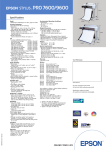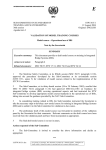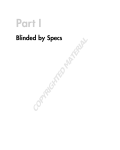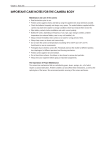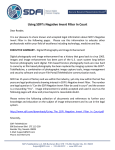Download to View for Free! - Nick Carver Photography
Transcript
THE FOLLOWING IS A FREE PREVIEW OF THE HOW TO SHOOT IN FULL MANUAL ONLINE COURSE BY NICK CARVER This is just 1 of 6 lesson guides from this course. Be sure to check out the free video here. All of my online photography courses are self-paced. That means you’ll have access to all 6 lesson guides and all 9 videos from day 1 of the course so that you can study as fast or as slow as you like. And with included lifetime course access, you’ll never lose access to the materials! Enrollment in this course includes: • 6 PDF Lesson Guides • 139 Pages in All • 218 Example Images • 136 Illustrations • 9 Video presentations • 2 Hours in All • Unlimited Email Support WWW .N ICK C ARVER P HOTOGRAPHY . COM Course Details & Enrollment: HERE View All Online Courses: HERE Discount Packages: HERE Questions? Email me at [email protected]. N ICK C ARVER P HO TO G RA PHY • WWW .N ICK C ARVER P H OTOGR AP H Y . COM • I N F O @N ICK C ARVER P H OTOGR AP H Y . COM F R E E P R E V I E W : H O W TO S HOOT IN F ULL M ANUAL • W EEK 2 1 WEEK 2 LESSON GUIDE AN THE APERTURE: IN-DEPTH EXPLANATION A Q UICK R EVIEW OF THE I M PORT A NT S T U F F Congratulations for making it through Week 1! If you were hoping to be shooting in Manual by the end of the first week’s lesson, hang in there. We have some more stuff to cover before then. But don’t worry, your tenacity will pay off in the long run. We’re going to cover your second exposure tool, the Aperture, this week. It’ll be a more in-depth explanation of the aperture than you’ll find anywhere else. The aperture can be pretty confusing even for those who have been shooting for awhile. That’s why I’ve devoted this entire week to a thorough discussion of the aperture that will completely demystify this tool so you can actually use it with confidence. Before we get into it though, I want to quickly review a few of the main points from last week. These are important to keep in mind throughout the entire course, so I’m going to beat this dead horse until the information is planted firmly in your memory. C O N T RO LLI NG E X POSU RE As we talked about last week, exposure is defined simply as the quantity of light registered by the digital sensor. It’s how much light the camera soaks up. And the camera can control how much light the sensor soaks up with 3 variables and 3 variables only: the shutter, the aperture and ISO. These are the only 3 tools you have for adjusting the exposure. Any one of these can cause the camera to register more light (i.e. make the image brighter) or register less light (i.e. make the image darker). Every time you take a picture, you or the camera has to choose a combination of these 3 tools that will render the image the correct brightness. When the camera’s doing it, the camera will decide how bright to make the image, and often times it doesn’t give you what you wanted. When shooting in full manual, you’ll decide how bright to make the image, and that’s what this course is all about. Figuring out how bright you want to make the picture is one thing, but choosing which one of the hundreds of different combinations of shutter, aperture and ISO to get that targeted brightness is something else entirely. Because remember, there isn’t just one combination of shutter, aperture and ISO that will get a correct exposure, there are hundreds. N ICK C ARVER P HO TO G RA PHY • WWW .N ICK C ARVER P H OTOGR AP H Y . COM • I N F O @N ICK C ARVER P H OTOGR AP H Y . COM F R E E P R E V I E W : H O W TO S HOOT IN F ULL M ANUAL • W EEK 2 2 As we learned last week, different shutter speeds will render motion differently. So, sometimes you may want a combination of shutter, aperture and ISO that will freeze the motion of your subject. Other times, you may want a combination that will blur the motion. It’s all up to you. Once you’ve nailed down how bright you want the image to be, then you can “juggle” the shutter, aperture and ISO settings until you get a combination that suits what you’re looking for. By the end of Week 3, once we’ve covered the aperture and ISO, you’ll be able to figure out what combinations of shutter, aperture and ISO give you equivalent exposures. Then we’ll tackle the topic of how to find the correct exposure. That’s manual metering and that’s what the final 3 weeks are all about. S T O PS Last week, I introduced the idea of “stops” to you. To refresh your memory, A stop is simply a halving or doubling of light. If you double the amount of light in your exposure, you went 1 stop brighter or you increased exposure by 1 stop. If you double the light again, you went 2 stops brighter than your original exposure. If you cut the amount of light in half, you went 1 stop darker. It’s always relative to another exposure value. These “stops” are the measurement system for light in photography and it’s how we calculate exposure, equivalent exposure settings and more. They are very important to understand. Last week, I showed you how the shutter speed is measured in time but it moves in stops. If you double the length of your shutter speed, you’ll let in twice as much light, or 1 stop more light. If you decrease your shutter speed by half, you’ll let in half as much light, or 1 stop less. And, of course, the shutter speed is divided up into third-stop increments so that you can make smaller jumps in exposure. I also mentioned last week that the aperture and ISO also move in stops. They each have their own measurement units, like the shutter speed, but they move in stops. So you can literally go, say, three stops brighter with the shutter and three stops darker with the aperture and they will cancel each other out to create an exactly equivalent exposure as you started with. So we covered one of your three exposure tools last week with the shutter speed. I showed you how it impacts the image, how it impacts exposure and how stops play into it. Let’s do the same with the aperture. N ICK C ARVER P HO TO G RA PHY • WWW .N ICK C ARVER P H OTOGR AP H Y . COM • I N F O @N ICK C ARVER P H OTOGR AP H Y . COM F R E E P R E V I E W : H O W TO S HOOT IN F ULL M ANUAL • W EEK 2 3 E XP O S UR E T O OL #2: T H E A PERTURE Inside your camera’s lens is where you’ll find the aperture. It’s an adjustable hole much like the pupil of your eye that can change diameter so as to adjust how much light gets through it. And, just like your pupils, it can never fully close. It can go from really wide to really narrow, but it can never close completely. Aperture As covered in the video from last week, here’s where the aperture is located (diagram at right). Here is a graphic representation of the aperture at different sizes as viewed from the front: W HAT T HE H ECK I S AN “F-S TOP ”? The length of time the shutter is open is measured in time. Time is something you and I are already familiar with so the shutter speed is a relatively simple thing to grasp. The aperture on the other hand is measured in something called “f-stops.” This term “f-stop” is completely proprietary to photography and is something you won’t find anywhere else in life, so be patient with yourself when using and learning it. It’s a brand new topic. It may take a little more time and effort to get a firm handle on it than with the shutter speed. The f-stop number simply indicates the diameter of the aperture. Sometimes they are written with an “f/” like “f/5.6”, and sometimes they just have an “f” in front of the number without the slash, like “F5.6” or “f5.6.” They all mean the same thing. Many photographers don’t even say or write the “F”. They’ll say, “I shot this picture at 5.6.” N ICK C ARVER P HO TO G RA PHY • WWW .N ICK C ARVER P H OTOGR AP H Y . COM • I N F O @N ICK C ARVER P H OTOGR AP H Y . COM F R E E P R E V I E W : H O W TO S HOOT IN F ULL M ANUAL • W EEK 2 4 Let’s break down this term “F-stop.” First off, what does the “F” stand for? Well, the way camera and lens manufacturers get these “F-numbers” like f/5.6 and f/11 and f/22 is from a formula. This formula has several measurements involved, including the physical diameter of the aperture opening. And like many formulas, this formula has a variable in it (a value that changes). This variable is actually the lens focal length, like 28mm, 50mm, 80mm, etc. The general consensus is that this “F” represents the variable of “Focal length.” So the “F” just represents the variable in the formula. The “Stop” part of “f-stop” should make sense now that we’ve covered stops. But truthfully, you don’t need to know what the “F” stands for. I went years not knowing what it meant and it never held me back. But if you have the space in your brain to store that little piece of information, more power to you. Okay, so that explains the term “F-stop”, but what do the numbers mean? As I mentioned above, these numbers are derived from a formula. This formula takes into account the area of the aperture opening, which brings in weird numbers like pi and r2. That means we get weird numbers like 5.6 and 2.8 and 3.5 for the f-stop. They look like weird numbers with seemingly random decimals, but you’d get the same numbers if you were to actually measure the diameter of the aperture opening, plug all the numbers into the formula and actually work it all out for yourself. But until you do that (I don’t recommend ever doing it, by the way) “f/5.6” won’t really make much sense to you. Basically, you’re just going to learn how these numbers affect the image because that’s what’s important. Just keep in mind that right now, f/5.6 might mean nothing to you. But 1,000 pictures from now, you’ll know exactly what it means. As if all this math stuff wasn’t confusing enough, the folks who invented the aperture decided to throw one last curveball at you. It’s one very important detail about the aperture and you’ll really need to burn this one into your brain. That is... The smaller the f-number, the larger the aperture. The larger the f-number, the smaller the aperture. Again... small f-number = large aperture large f-number = small aperture N ICK C ARVER P HO TO G RA PHY • WWW .N ICK C ARVER P H OTOGR AP H Y . COM • I N F O @N ICK C ARVER P H OTOGR AP H Y . COM F R E E P R E V I E W : H O W TO S HOOT IN F ULL M ANUAL • W EEK 2 5 For example: f/4 f/10 f/20 See how the smaller numbers are bigger holes and the bigger numbers are smaller holes? I know, it’s confusing and it’s going to drive you nuts for awhile — it does that to everyone. Did to me, too. Or maybe you’re way ahead of the game and you already have a firm handle on this. If that’s the case, kudos. This course is going to be quite a bit easier for you. But this detail about the aperture is ABSOLUTELY vital to understand. The sooner you burn it into your head, the easier it will be to use the aperture. Believe it or not, this isn’t just to confuse you. There actually is a reason the smaller numbers are bigger holes and vice versa. These f-numbers are actually the denominator of a fraction that represents the size of the aperture opening. And when the denominator (the bottom number of a fraction) is bigger, the fraction is smaller. Like 1/20 is a lot smaller than 1/4. So, you could really imagine the “f” as a 1, turning the numbers into fractions, and it will make a lot more sense: 1/4 1/10 1/20 With the “f” replaced by a 1, the numbers make a little more sense. 1/4 is bigger than 1/10 which is bigger than 1/20 I’m not big on “tricks” to help remember things. All those “shutter, aperture, ISO triangles” and comparisons of the aperture to a donut, etc., etc. you’ll read elsewhere are tricks to help you remember these things. But they are just that—tricks. They’ll more than likely make things more confusing. N ICK C ARVER P HO TO G RA PHY • WWW .N ICK C ARVER P H OTOGR AP H Y . COM • I N F O @N ICK C ARVER P H OTOGR AP H Y . COM F R E E P R E V I E W : H O W TO S HOOT IN F ULL M ANUAL • W EEK 2 6 Actually learning the material through study, practice and repetition is the better way to go. Then it will stick with you for good. You didn’t use any tricks to help you learn English, you just learned it. Treat photography the same way. But this little “trick” with the aperture isn’t a trick at all because that’s how the f-numbers actually work. The smaller numbers are the denominators of larger fractions. That’s why smaller f-stop numbers are larger holes. Important Note: Since the smaller numbers are bigger apertures and the bigger numbers are smaller apertures, it can get a little confusing knowing what people are talking about. For instance, you read “Use a big aperture for portraits.” Then you’re left wondering if that means a big hole or a big number. See how this can get confusing? Well, photographers who know what they’re talking about tend to refer to the aperture as the size of the hole, not the number — meaning, if I were to tell you “Use a big aperture for portraits,” I mean use a big opening, which as we just learned, would be a small number. Really understand what I just said here. You might need to read it a few times and really work it out, but it’s important. H OW T HE A PE R T U R E I MPACTS E X P O S U R E From the start of this course, you may have noticed that I’ve been likening exposure to soaking up water. That’s because in photography, light behaves a lot like water. If you let your light-sponge (that is, your image sensor) soak up light for a longer period of time via the shutter speed, then it will collect more light and, thus, make the image brighter. Well, just like water, if you try to pass light through a smaller opening, then less will get through to the sponge. That’s where the aperture comes in. The aperture is just an opening inside your lens that lets the light through. It’s like a hose in that sense. But unlike a hose, the aperture can change its diameter on the fly. You can go from a drinking straw to a garden hose to a fire hose with just a flick of the control wheel. So that’s why the aperture can change diameter, so it can control how much light the sensor will soak up. Does that statement sound familiar? You’ll remember from last week that the shutter can be open for different lengths of time so it can control how much light the sensor will soak up. So you see, the aperture exists for the same reason the shutter exists: to let in more or less light. For example, an aperture of f/2.8 is wider than an aperture of f/11 (remember, bigger number = smaller opening). So f/2.8 will let in more light than f/11. An aperture of f/22 is much smaller than an aperture of f/4. So, f/22 will let in far less light than f/4. N ICK C ARVER P HO TO G RA PHY • WWW .N ICK C ARVER P H OTOGR AP H Y . COM • I N F O @N ICK C ARVER P H OTOGR AP H Y . COM F R E E P R E V I E W : H O W TO S HOOT IN F ULL M ANUAL • W EEK 2 7 The following diagram helps illustrate this: Wide Aperture Lets in More Light f/2.8 f/4 f/5.6 f/8 f/11 f/16 f/22 Narrow Aperture Lets in Less Light f/32 In the following examples, the only thing that changed was the aperture. I kept the other 2 exposure tools the same (the shutter speed and the ISO). These examples are only demonstrating that wider apertures let in more light while smaller apertures let in less light. Shutter Speed: 1/500 Aperture: f/11 ISO: 400 Shutter Speed: 1/500 Aperture: f/7.1 ISO: 400 Shutter Speed: 1/500 Aperture: f/4.5 ISO: 400 N ICK C ARVER P HO TO G RA PHY • WWW .N ICK C ARVER P H OTOGR AP H Y . COM • I N F O @N ICK C ARVER P H OTOGR AP H Y . COM F R E E P R E V I E W : H O W TO S HOOT IN F ULL M ANUAL • W EEK 2 8 Notice how the widest aperture (smallest f-stop number) created the brightest image, and the smallest aperture (largest f-stop number) created the darkest image. This is because the wider apertures let more light through than the smaller apertures, like a garden hose compared to a drinking straw. H OW S TOPS P LAY I N TO THE A PE R T U R E Let’s see how stops play in to the aperture. Here are your apertures (these can also be found on the “Cheat Sheet” at the Curriculum Homepage). Your lens(es) might have more apertures than you see below or, more likely, less apertures than you see below. We’ll get to why that is in a little while. f/2.8 f/3.2 f/3.5 f/4 f/4.5 f/5 f/5.6 f/6.3 f/7.1 f/8 f/9 f/10 f/11 f/13 f/14 f/16 f/18 f/20 f/22 f/25 f/29 f/32 We have real wide apertures that let in a lot of light towards the upper left and really small apertures that let in very little light to the lower right. Important Note: To find where the aperture is indicated on your camera, refer to your user manual. Keep in mind that many cameras don’t display the “f/” before the f-number. For example, for an aperture of f/5.6, the camera will only show “5.6”. Just like last week with the shutter speeds, let’s look at the f-stops in bold... f/2.8 f/3.2 f/3.5 f/4 f/4.5 f/5 f/5.6 f/6.3 f/7.1 f/8 f/9 f/10 f/11 f/13 f/14 f/16 f/18 f/20 f/22 f/25 f/29 f/32 These apertures are all 1 stop apart from each other as you move left or right. The unfortunate thing with the aperture is there is no visual pattern like with the shutter speeds. If you have a shutter speed of 4”, you can easily figure out the shutter speed that’s 1-stop brighter by simply doubling 4” to 8”. But we can’t do that with the apertures. These ones you’ll just start to remember as you shoot more. There’s no visual pattern with the aperture numbers because, again, these f-numbers are derived from a formula that takes into account the area of a circle. If you were to work this formula out, you’d find that an aperture of f/2.8 has an area twice as large as f/4, so it will let in twice as much light, or 1 stop more light. Per the formula, an aperture of f/22 has an area half as large as f/16, so it will let in half as much light, or 1 stop less light. Remember, a stop is a halving or doubling of light. So, these apertures will let in 1 stop more light as you move left and 1 stop less light as you move right. N ICK C ARVER P HO TO G RA PHY • WWW .N ICK C ARVER P H OTOGR AP H Y . COM • I N F O @N ICK C ARVER P H OTOGR AP H Y . COM F R E E P R E V I E W : H O W TO S HOOT IN F ULL M ANUAL • W EEK 2 9 For example... If you go from f/5.6 to f/8, you’ll cut the light in half (1 stop darker). If you go from f/4 to f/2.8, you’ll double the light (1 stop brighter). If you go from f/11 to f/16, you’ll cut the light in half (1 stop darker). If you go from f/32 to f/22, you’ll double the light (1 stop brighter). Get it? Look at the following pictures. Notice how they are all 1 stop apart and their apertures are 1 stop apart. The shutter and ISO settings were the same in each picture (f1/500 and ISO 400). 1 stop darker 1 stop darker 1 stop brighter f/11 1 stop brighter f/8 f/5.6 And like the shutter speed, these f-stop numbers are divided up into third-stop increments. f/2.8 f/3.2 f/3.5 f/4 f/4.5 f/5 f/5.6 f/6.3 f/7.1 f/8 f/9 f/10 f/11 f/13 f/14 f/16 f/18 f/20 f/22 f/25 f/29 f/32 Again, the numbers don’t have any visual pattern, but if you take any aperture and move 3 spaces to the right, you’ll get an aperture that’s 1 stop darker. Take any aperture and move 3 spaces to the left and you’ll get an aperture that’s 1 stop brighter. N ICK C ARVER P HO TO G RA PHY • WWW .N ICK C ARVER P H OTOGR AP H Y . COM • I N F O @N ICK C ARVER P H OTOGR AP H Y . COM F R E E P R E V I E W : H O W TO S HOOT IN F ULL M ANUAL • W EEK 2 10 For instance, if you take an aperture of f/6.3 and move 3 spaces to the right, you’ll get an aperture of f/9, which is one stop smaller and darker than f/6.3. If you take an aperture of f/20 and move 3 spaces to the left, you’ll get an aperture of f/14, which is one stop wider and brighter than f/20. So that’s how stops play in to the aperture. The aperture moves in stops. A P E R T UR E S A VA IL A BL E TO Y OU Chances are your lens doesn’t go all the way to f/2.8. Your lens might stop at f/3.5 or f/4 or even f/5.6. This is because different lenses “dead end” at different apertures. The widest aperture (meaning the smallest f-number) that your lens allows you to reach is called the lens’s “maximum aperture.” Some lenses have a maximum aperture of f/2.8 while others have a maximum aperture of f/5.6. Some can go even wider than f/2.8 all the way to f/1.2. Your lens’s maximum aperture will determine the biggest aperture you can use. This maximum aperture is one of the biggest deciding factors in size, weight and price of a lens. For example, in the image to the right, both lenses are 300mm lenses, so they will give the exact same magnification. The lens on the left has a maximum aperture of f/4, it weighs 2.6 pounds and it costs $1,300. The lens on the right, however, has a wider maximum aperture of f/2.8 (just 1 stop wider), it weighs 6 pounds and it costs $5,500! That’s a lot of weight and cash for just 1 stop more light, but for certain types of photography, it’s worth every penny and pound. Why pay over twice the price and carry over twice the weight for a bigger aperture? Because a bigger aperture will let in more light, allowing you to shoot in low light environments and use faster shutter speeds — that can be a big deal in sports and wildlife photography. If you have a zoom lens, there’s a real good chance its maximum aperture will change as you zoom in or out. Professional series lenses often have an aperture of, say, f/2.8 throughout the entire zoom range. So it if zooms from 24mm to 70mm, then you’ll be able to use f/2.8 at 24mm and all the way up through 70mm. But most lenses on the market, including kit lenses that come with the camera, will have what’s called a variable maximum aperture. That means that it will have a different maximum aperture when zoomed in to 70mm than when zoomed out to 24mm. It might have a max aperture of f/3.5 at 24mm, but then drop to a max aperture of f/5.6 at 70mm. So, basically, you lose some of your widest apertures when you zoom in. They make lenses this way so they can be smaller, lighter weight and cheaper. It’s a trade-off, but everything in photography is. N ICK C ARVER P HO TO G RA PHY • WWW .N ICK C ARVER P H OTOGR AP H Y . COM • I N F O @N ICK C ARVER P H OTOGR AP H Y . COM F R E E P R E V I E W : H O W TO S HOOT IN F ULL M ANUAL • W EEK 2 H OW THE 11 A PE R T U R E A F F E C T S THE I MAGE We’ve talked extensively about how a change in the shutter speed can negate a change in the aperture. For example, let in 2 stops more light with a wider aperture and let in 2 stops less light with a faster shutter speed and the image will remain the same brightness. This gives us a lot of options for exposure settings. Last week, I showed you how the shutter speed has a “side-effect” on the image in which motion blur is rendered differently. Well, surprise, surprise, the aperture has a side-effect, too. Its side-effect is the depth of field. Depth of field can be defined simply as the area of the image that appears in focus from front to back. Side to side, everything will always be equally in focus — meaning, anything that is the same distance from you will be in focus equally. A person 10 feet away from you will be equally in focus as the tree next to them that’s also 10 feet away. The mountain in the background, though, that’s 3 miles away probably won’t be in focus. That’s where depth of field comes in. In photography, we can have different depths of field (often abbreviated “DOF”). A small or narrow depth of field (DOF) would be when only a small amount of the image is in focus from front to back. A large or wide depth of field (DOF) would have much more in focus from front to back. For example: Only a small part of this image is in focus from front to back because it has a small depth of field A great distance in this scene is in focus from front to back because the image has a large depth of field Those beautiful portraits you see where the background is nice and blurry but the subject is sharp and infocus — that’s a narrow depth of field. N ICK C ARVER P HO TO G RA PHY • WWW .N ICK C ARVER P H OTOGR AP H Y . COM • I N F O @N ICK C ARVER P H OTOGR AP H Y . COM F R E E P R E V I E W : H O W TO S HOOT IN F ULL M ANUAL • W EEK 2 12 Those landscapes where everything is in focus from the rocks in the foreground to the mountain in the background — that’s a wide depth of field. The aperture can affect the DOF in your image. Basically, changing the aperture will affect how much of the image is in focus from front to back. To put it simply: The larger the aperture, the smaller the depth of field. The smaller the aperture, the larger the depth of field. Again... large aperture = small DOF small aperture = large DOF So, a large aperture will have less in focus from front to back. A small aperture will have more in focus from front to back. Why is this? Couldn’t tell ya. It’s just how physics works. A bigger opening will put less in focus while a smaller opening will put more in focus. That’s what’s important to know. This image with the small DOF had an aperture of f/5.6 — a very wide aperture. N ICK C ARVER P HO TO G RA PHY • WWW .N ICK C ARVER P H OTOGR AP H Y . COM • I N F O @N ICK C ARVER P H OTOGR AP H Y . COM F R E E P R E V I E W : H O W TO S HOOT IN F ULL M ANUAL • W EEK 2 13 This image with the big DOF had an aperture of f/20 — a very small aperture. See how the larger aperture (smaller f-number) created a smaller DOF while the smaller aperture (bigger f-number) created a bigger DOF? I know, I know...all this back and forth between small and large and wide and narrow is getting confusing. Here’s a diagram to help: Small DOF f/2.8 f/4 f/5.6 f/8 f/11 f/16 f/22 Big DOF f/32 N ICK C ARVER P HO TO G RA PHY • WWW .N ICK C ARVER P H OTOGR AP H Y . COM • I N F O @N ICK C ARVER P H OTOGR AP H Y . COM F R E E P R E V I E W : H O W TO S HOOT IN F ULL M ANUAL • W EEK 2 14 On this diagram, you’ll see that the bigger apertures are smaller f-numbers which create a smaller DOF. The smaller apertures are bigger f-numbers which create a bigger DOF. So that’s actually an easy, shortcut way to remember it: smaller f-stop numbers = smaller DOF larger f-stop numbers = larger DOF That makes it a little bit easier to remember, right? Here is a sequence of shots demonstrating this change in DOF depending on the aperture value: f/4 f/8 f/16 f/32 N ICK C ARVER P HO TO G RA PHY • WWW .N ICK C ARVER P H OTOGR AP H Y . COM • I N F O @N ICK C ARVER P H OTOGR AP H Y . COM F R E E P R E V I E W : H O W TO S HOOT IN F ULL M ANUAL • W EEK 2 15 See how with the smaller apertures, the DOF increases and more of the image comes in focus? Just to further drive this home, here are some side-view illustrations of how the aperture affects the DOF. In each illustration, the camera remains focused on the tree. Point of focus f/4 DOF Point of focus f/11 DOF Point of focus f/22 DOF N ICK C ARVER P HO TO G RA PHY • WWW .N ICK C ARVER P H OTOGR AP H Y . COM • I N F O @N ICK C ARVER P H OTOGR AP H Y . COM F R E E P R E V I E W : H O W TO S HOOT IN F ULL M ANUAL • W EEK 2 16 You’ll notice in these illustrations that the DOF extends further behind the tree than it does in front. It actually does work that way in real life. In fact, the DOF extends ⅔ behind your subject (where your camera is focused) and ⅓ in front of your subject. W HAT A PE R T U R E S Y OU C A N U S E As discussed previously, the apertures available to you will be determined by your lens. And you can technically use any one of these apertures in any lighting scenario. But just because you can technically use any aperture doesn’t mean you should. W HAT A P E R T U R E S Y OU S HOULD U S E The aperture you should use will be determined by two things: 1. How much DOF do you want in your shot? 2. What apertures will give you an acceptable shutter speed? Let’s talk about the DOF first. I just showed you how different apertures will give you different depths of field. So, the aperture you should use depends on what DOF you want. If you want a sharp background with a lot in focus from front to back, use a small aperture like f/18 or f/22. If you want a blurry background with very little in focus from front to back, use a wide aperture like f/2.8. I can’t tell you how much DOF each aperture will give you because there are a couple other variables that affect DOF, which we’ll get to by the end of this lesson. You’ll just have to experiment. Here are several real-life example pictures and the apertures I used: To get a big DOF and render everything in focus from the river in the foreground to the mountain peaks in the background, I used a small aperture of f/18 N ICK C ARVER P HO TO G RA PHY • WWW .N ICK C ARVER P H OTOGR AP H Y . COM • I N F O @N ICK C ARVER P H OTOGR AP H Y . COM F R E E P R E V I E W : H O W TO S HOOT IN F ULL M ANUAL • W EEK 2 17 Here I wanted just a small part of the picture to be in focus for a more abstract composition, so I chose a wide aperture of f/2.8 To draw more attention to the eyes of this model, I wanted a small DOF from f/2.8 to blur out the background and even her shirt and shoulders. In this picture, I wanted the background to be just a little bit blurry, but not completely blurry, so as to pull a little more attention to the blades of grass. A mid-range aperture of f/13 did the trick. N ICK C ARVER P HO TO G RA PHY • WWW .N ICK C ARVER P H OTOGR AP H Y . COM • I N F O @N ICK C ARVER P H OTOGR AP H Y . COM F R E E P R E V I E W : H O W TO S HOOT IN F ULL M ANUAL • W EEK 2 18 In this picture, I wanted draw as much attention as possible to the sharp cactus. By using a midrange aperture of f/11, I was able to blur the background just enough to make that foreground cactus look even sharper by comparison. To isolate my subject and pull more attention to his face, I used a wide aperture of f/4.5 so as to create a narrow DOF. Here I wanted everything in focus from the rocks in the foreground to the cliffs in the background, so I chose a small aperture of f/20 N ICK C ARVER P HO TO G RA PHY • WWW .N ICK C ARVER P H OTOGR AP H Y . COM • I N F O @N ICK C ARVER P H OTOGR AP H Y . COM F R E E P R E V I E W : H O W TO S HOOT IN F ULL M ANUAL • W EEK 2 In this shot, I wanted the background to be a tiny bit blurry, but not indiscernible, so I chose a mid-range aperture of f/10 19 To get a soft, artistic look to this image, I chose a wide aperture of f/2.8, which gave me a small DOF For a more abstract look, I chose a small DOF achieved by a wide aperture of f/5.6 N ICK C ARVER P HO TO G RA PHY • WWW .N ICK C ARVER P H OTOGR AP H Y . COM • I N F O @N ICK C ARVER P H OTOGR AP H Y . COM F R E E P R E V I E W : H O W TO S HOOT IN F ULL M ANUAL • W EEK 2 20 So that’s the first point: How much DOF you want in your shot. But what about the second point? What apertures will give you an acceptable shutter speed? This is generally the bigger of the two barriers when choosing an aperture. Sometimes you want a sharp background, but the aperture you need to get that big DOF requires you to use an unacceptable shutter speed. Here’s how it works... A smaller aperture will give you more DOF, but it will let in less light. Since the aperture is letting in less light, the shutter speed will have to let in more light to compensate. That means you’ll need a longer shutter speed. Well, if you’re trying to freeze the motion of a bird flying through the air or an athlete running a play, then you’re in trouble. Conversely, a wider aperture will give you a nice, blurry background, but it will let in more light. Since the aperture is letting in more light, the shutter speed will have to let in less light to compensate. That means you’ll need a faster shutter speed. But if you’re trying to blur the motion of a waterfall for that cool cotton look, then you have a problem. The good news is, often times it works in your favor. For instance, when shooting wildlife or sports, you often want that narrow DOF for a blurry background. Well, that means you should use a wide aperture. A wide aperture will let in lots of light, which means you can let in less light with a faster shutter speed. Since you’re trying to freeze the motion of a moving subject anyway, that works out pretty well. A wide aperture of f/2.8 let in a lot of light, which allowed me to use a fast shutter speed of 1/6400. The wide aperture also gave me a small DOF, which blurred out the background nicely. N ICK C ARVER P HO TO G RA PHY • WWW .N ICK C ARVER P H OTOGR AP H Y . COM • I N F O @N ICK C ARVER P H OTOGR AP H Y . COM F R E E P R E V I E W : H O W TO S HOOT IN F ULL M ANUAL • W EEK 2 21 So, really, you mainly get into trouble when you want a big DOF (which means using a small aperture), but you also want a pretty fast shutter speed to freeze the motion. Those two things don’t go hand-inhand. Here’s one example where I ran into this exact problem: Here I wanted a big DOF so everything would be in focus from front to back. That meant I needed to use a small aperture of f/18. This small aperture didn’t let in very much light, so I was forced to use a long shutter speed, which caused the grass blowing in the wind to blur. So when figuring out your aperture, you’ll need to keep those two things in mind. 1. How much DOF do you want in your shot? 2. What apertures will give you an acceptable shutter speed? T W O F I N A L I M PO RT A N T N OT ES ON DOF We just learned all about the aperture and how it affects DOF, and most courses would stop there. But there are two more sections I want to cover before calling it a day. O THER T HINGS T HAT A F F E C T DOF Yes, the aperture affects the DOF. But that isn’t the only thing that affects the DOF in your shot. There are two other important variables that impact DOF. N ICK C ARVER P HO TO G RA PHY • WWW .N ICK C ARVER P H OTOGR AP H Y . COM • I N F O @N ICK C ARVER P H OTOGR AP H Y . COM F R E E P R E V I E W : H O W TO S HOOT IN F ULL M ANUAL • W EEK 2 22 The first is the distance to your subject. The closer you get to something, the smaller DOF gets. The further away your subject is, the bigger DOF gets. So for close-up photography of bugs and flowers, it can be difficult to get a big DOF. An aperture of f/4 may give you a DOF that’s literally razor thin. But if you keep your aperture at f/4 and now you go to photograph a mountain that’s a mile away, your DOF will expand to cover many miles. The further away your subject is, the bigger DOF is at the same aperture. The second variable that affects DOF in addition to the aperture is your focal length. The longer the focal length (i.e. the more “zoomed in” your lens is), the smaller DOF is. The shorter the focal length (i.e. the more “zoomed out” your lens is), the bigger the DOF. Let’s say you’re going to photograph a hawk perched on a tree, you want it to fill the frame from talons to head and you’re going to use an aperture of f/4 no matter what. If you photograph it with a 50mm lens, the DOF will be greater than if you use a 200mm lens. The 200mm lens at f/4 will create a blurrier background than 50mm at f/4. So to summarize: 1. The closer you are to your subject, the smaller the DOF. 2. The longer the focal length you use, the smaller the DOF. So with really wide angle lenses like 10-17mm, it can be very difficult to get a narrow DOF even if you use something like f/2.8. That’s because this short focal length lens has a naturally wide DOF. And with a long lens like 200mm, it’s much harder to get a big DOF even if you use a small aperture like f/32. And you can file this under the “I don’t really know why this happens” category. DOF P RE V IE W B UTTON There’s something very, very important to keep in mind when you work with the aperture: When you look through your viewfinder, you aren’t necessarily seeing the DOF you’re going to get with the aperture you’ve chosen. When you look through your viewfinder, your camera’s aperture is wide open — no matter what. Even if you’ve chosen a really small aperture so you can get a big DOF and a sharp background, the view through your viewfinder is through the widest aperture your lens has. So let’s say you’re going to use an aperture of f/32 because you want everything in focus from front to back. But your lens’s maximum aperture is f/4. Well, when you frame up your shot and look through the N ICK C ARVER P HO TO G RA PHY • WWW .N ICK C ARVER P H OTOGR AP H Y . COM • I N F O @N ICK C ARVER P H OTOGR AP H Y . COM F R E E P R E V I E W : H O W TO S HOOT IN F ULL M ANUAL • W EEK 2 23 viewfinder, the image you see is at an aperture of f/4, not f/32. So the DOF you see in the viewfinder is not the DOF you’ll get in the picture. This is what you see through the viewfinder DOF of lens’s max aperture of f/4 This is how the image will turn out DOF of user-selected aperture of f/32 The aperture doesn’t close down to what you’ve chosen until you actually take the picture. At all other times, the aperture is wide open. When you look through the viewfinder, you’re looking through your lens’s widest aperture. Camera manufacturers design their cameras to operate this way so that you have the brightest image possible when looking through the viewfinder. It makes composing the shot easier. But let’s say you want to preview the DOF you’ll get at f/20 — you want to know if it’ll give you everything in focus you want. You could take a picture, then look at the review screen to see if it gave you the DOF you needed, but that extra time might make you miss some important opportunities and the screen may be too small and hard to see in direct sunlight. That’s why the camera gods gave us the depth of field preview button. Not every camera has it, but most do nowadays. It’s a little button on the front of your camera typically next to the base of where the lens meets the camera body. When you press this button, it will temporarily close down the aperture to whatever f-stop you’ve selected so you can look through the viewfinder and see the DOF as it will be in the final picture. To use it, just look through your viewfinder while you press the button and you’ll see the DOF as it will appear in the final shot. The viewfinder will go darker but that’s just because you’re looking through a smaller aperture. Keep in mind that just because the viewfinder goes darker it does not mean your picture will be darker. The viewfinder going dark is just a side-effect of looking through the smaller N ICK C ARVER P HO TO G RA PHY • WWW .N ICK C ARVER P H OTOGR AP H Y . COM • I N F O @N ICK C ARVER P H OTOGR AP H Y . COM F R E E P R E V I E W : H O W TO S HOOT IN F ULL M ANUAL • W EEK 2 24 aperture. What you’re really looking for is the change in DOF. So when you press the DOF preview button, keep an eye on everything that’s out of focus. It will sharpen up if you’ve chosen an aperture smaller than the maximum for your lens. DOF Preview Button DOF Preview Button VIDEO PRESENTATION Go to the Curriculum Homepage where you got this lesson guide and watch the Video Presentation entitled “The Aperture Explained” ASSIGNMENT Using the information in this week’s lesson guide and the cheat sheet provided at the Curriculum Homepage, answer the following questions: 1. If I change my aperture from f/8 to f/11, did I let in more or less light? How many stops more or less? 2. If I change my aperture from f/4 to f/7.1, did I let in more or less light? How many stops more or less? 3. What aperture lets in 1 stop more light than an aperture of f/32? 4. What aperture lets in 2 ⅓ stops less light than an aperture of f/2.8? 5. What aperture has a greater DOF, f/6.3 or f/9? Which one lets in more light? N ICK C ARVER P HO TO G RA PHY • WWW .N ICK C ARVER P H OTOGR AP H Y . COM • I N F O @N ICK C ARVER P H OTOGR AP H Y . COM F R E E P R E V I E W : H O W TO S HOOT IN F ULL M ANUAL • W EEK 2 25 Email your answers to me at [email protected]. Then, put your camera on aperture priority mode (“Av” for Canon and “A” for Nikon) and shoot a single subject that has a background at least 10 feet away. Keep your lens at a focal length of 50mm or longer. Take pictures of this subject at different apertures to see how it affects DOF. Email me 2 pictures: one with a small DOF and one with a big DOF. THINGS TO REMEMBER ABOUT THE APERTURE: • The aperture is measured in f-stops, but it moves in stops. • Larger f-stop numbers represent smaller apertures. Smaller f-stop numbers represent larger apertures. • The aperture you choose will impact the shutter speed. If you don’t let in much light with a small aperture, the camera will have to use a longer shutter speed. Remember how the shutter speed affects motion blur, so don’t use an aperture that yields too slow of a shutter speed. All content, graphics and images copyright © Nick Carver. No portion of this material or course may be duplicated, reproduced, distributed or otherwise shared in any form without the expressed consent of Nick Carver. N ICK C ARVER P HO TO G RA PHY • WWW .N ICK C ARVER P H OTOGR AP H Y . COM • I N F O @N ICK C ARVER P H OTOGR AP H Y . COM THE PRECEDING WAS A FREE PREVIEW OF THE HOW TO SHOOT IN FULL MANUAL ONLINE COURSE BY NICK CARVER Thank you for taking the time to sample this course! Enroll today to gain access to the entirety of this course including: • 6 PDF Lesson Guides • 139 Pages in All • 218 Example Images • 136 Illustrations • 9 Video presentations • 2 Hours in All • Unlimited Email Support WWW .N ICK C ARVER P HOTOGRAPHY . COM Course Details & Enrollment: HERE View All Online Courses: HERE Discount Packages: HERE Questions? Email me at [email protected]. N ICK C ARVER P HO TO G RA PHY • WWW .N ICK C ARVER P H OTOGR AP H Y . COM • I N F O @N ICK C ARVER P H OTOGR AP H Y . COM



























